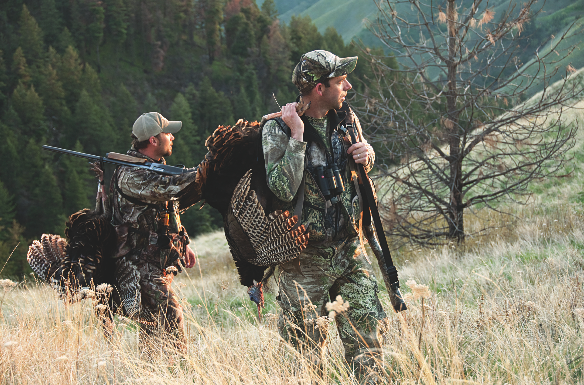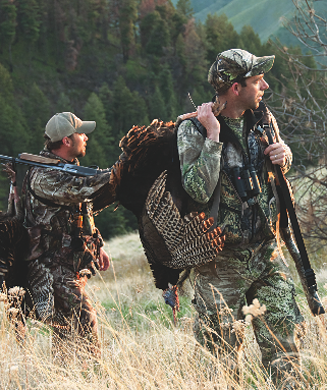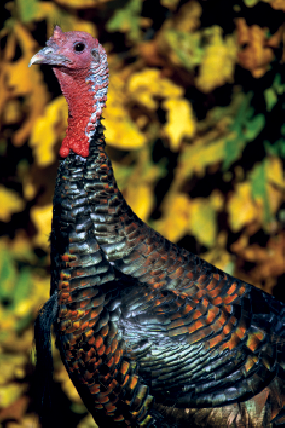

Twenty-five years later, the birds are still making it, and at the moment they are in no danger from me, though I have an Idaho turkey tag in my pocket, a slate call that purrs like a satin-gloved madam, and a 3'Äa1'ÅÑ2 -inch Browning Gold loaded with head-jellying Winchester No. 5s. I've been all over Reggear's farm the last two days, trying to close the distance on gobblers that, like chatty freshmen, are eager to talk but don't seem to know how to act on their indecent impulses. I'm here to hunt an Eastern gobbler in the West, but right now these birds are acting a lot more like the other occupants of these ridges: elk. That is to say, they are using every inch of this huge landscape, covering miles in just a few hours, and are so sensitive to hunting pressure that they vanish like ink in the ocean. When the gobblers pitch down from their finger-ridge roost, they fly a half-mile across a steep drainage to catch the morning sun in a meadow that I can see directly across the canyon but which takes me three rock-scrambling hours to reach. My legs burn from the climb, my face and arms are scratched from fighting through thorny underbrush, and even though I hear toms gobbling all day, I have yet to see one of these wide-ranging birds. So far I've found more elk sheds here than turkey feathers.

Other hunters are having better luck. When I stop at Riverside Sports Shop in Orofino — Steelhead Capital of the World — dozen camouflaged hunters are gathered around a pickup bed. In another season they might be admiring a trophy bull, but today they're inspecting a pair of gobblers. In the West, spring turkey season is the fastest-growing segment of hunting. Here in Idaho, the state sold slightly more than 5,000 turkey licenses in 1994. Last year nearly 60,000 licenses were sold. In neighboring Washington, license sales jumped from 2,800 in 1994 to nearly 20,000 last year. If that sort of growth pervaded other shooting sports, America would be awash with hunters. But the number of hunters in the United States is relatively stagnant, even declining some years. So why is turkey hunting so popular in an area of the country more commonly associated with antlered ungulates? Much of the credit goes to the National Wild Turkey Federation, but whether for establishing turkey populations or making big-game hunters aware of the remarkable resource out their back doors is a chicken-or-egg sort of question. What is clear is that through its fund-raising dinners, the NWTF has been instrumental in growing both its membership and its investment in wildlife habitat over the last two decades.


Wild turkeys are not native to most of the West north of the Colorado River and west of the Missouri River. Starting in the 1950s, state wildlife managers began trapping birds in their native range — Merriam — from the Four Corners area of Colorado and New Mexico, Easterns from Pennsylvania and North Dakota and Rio Grande turkeys from the Texas and Oklahoma plains and planting them in vacant habitat from northern Idaho to southern California. In those early years, game agencies had little regard for, or knowledge of, the specific habitat requirements of the various subspecies. That's how Easterns arrived at Dworshak Reservoir, Rio Grande turkeys populated tributaries of the Snake River and Merriam's got to such diverse habitat as eastern Montana's grain belt and Oregon's high desert. These days, it's generally agreed that Merriam's turkeys‚ a subspecies that thrives in mid-elevation ponderosa pine habitat, is best suited to most areas of the West. In fact, in Montana, legislation mandates that Merriam's is the only subspecies that will be actively managed in the state.



Folks who have hunted only Eastern turkeys on Southern pine plantations or Midwestern bottomlands can't conceive of the amount of real estate Western gobblers can cover. Or the kind of country they occupy. Only a fraction of Reggear's property is level. The rest is steep as a cow's face, so inclined that I can stick a decoy in the ground without ever bending over. I'm surprised these birds don't have freakishly large thighs, given the elevation they have to cover over the course of an average day. They roost on skyline ridges that can be 2,000 feet higher than the valley floor feeding areas. So to hunt them you have to be part sherpa and, when they're as unresponsive as they are being right now, willing to hike miles to strike a hot tom. Finally, as a May snowstorm drops flakes as big and fluffy as marshmallows on Reggear's timber, I find him. Two gobblers are tending hens in a meadow below the ruins of a homesteader's shack on a high, open ridge. One struts every time I yelp, and starts my way only to be reeled back in by possessive hens. The only way to get him in range will be to close the distance, moving undetected across the overgrown meadow.














